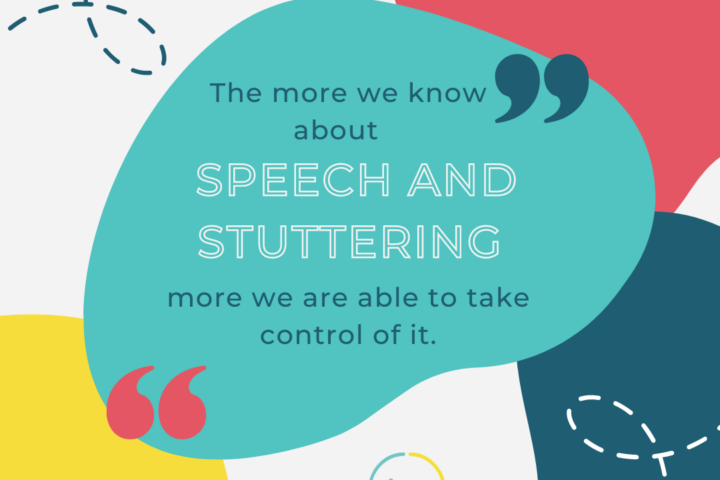If you’re a speech-language pathologist, there is a strong chance that you’ve been asked about stuttering by concerned parents. A lot of parents want to know what’s “normal” when it comes to stuttering and their child. Others ask questions like, “Should we just wait and see?”
These are difficult questions to answer because stuttering is rather complicated.

Children can go through periods of disfluency, or stuttering, when they’re developing new vocabulary or language skills. This is called developmental stuttering. Thus, many medical professionals, some SLPs included, opt for a “wait and see” approach. It is often recommended that parents monitor their child’s speech for 6 months after they notice suspected stuttering and then seek an evaluation and interventions. I guess I can understand this. I’m a panic-er by nature. Sometimes I need to take a step back and evaluate situations before I act because if I acted on everything I panicked about, I basically would be at my doctor’s office everyday!
But, hm.
So, how do you know if it’s time to seek services for a “true” stutter? For me, there are a few signs of stuttering of which parents should be aware.
Pattern
We all have moments in our day when we’re not fluent. I stumble over my words or forget where I’m going with conversations or repeat myself a lot. Kiddos do this, too. Kids are distracted. They’re trying to find words for what they’re attempting to convey. They’re learning new vocabulary and sentence structure and nuances of language everyday. Thus, it would stand to reason that they might have moments where they are disfluent.
True stuttering has a really specific pattern, though. It consists of:
-
Single sound repetitions (part-word repetitions): I-I-I-I got a book.
-
Syllable repetition (whole word repetitions): We-we-we went to the beach.
-
Blocks: Think of these as long pauses before words. Sometimes, irregular jaw movement or rapid eye blinking might occur during this pause.
-
Prolongations: Sssssomeone said my name.
Most true stuttering occurs at the beginning of a sentence and at the beginning of words.
These stuttering moments can be accompanied by physical secondary behaviors such as rapid blinking, fidgety hands and feet, avoiding eye contact, and irregular jaw movements. Emotional secondary behaviors such as avoidance of certain situations or words and low self-esteem can also accompany the stuttering.
If your kiddo is showing consistent patterns of disfluency in addition to having those secondary behaviors, make an appointment with a speech-language pathologist.
Predictors of Persistence
Researchers have tried and tried to figure out the cause of stuttering. There have been many idea as to the cause, but the prevailing THEORY (and I do mean THEORY) is that it has something to do with the brain and genetics. Do they know what in the brain causes it? No. Do they know that, without a doubt, it is something with the brain? No.
Furthermore, 75-80% of children who stutter eventually stop (often through the help of SLPs), but 20-25% of children have persistent stuttering throughout their lives. While we don’t have a “cause” of stuttering, we do know that certain factors may point to persistent stuttering. These factors are:
-
Genetics: A child with a parent who stutters, especially a parent who has persistent stuttering, is more likely to have persistent stuttering.
-
Gender: Males tend to be more at risk for persistent stuttering than females. In childhood, the male:female stuttering ratio is 2:1, whereas in adulthood, the ratio is 4:1.
-
Age of onset of stuttering: The later the onset of stuttering, the more likely it is that the stuttering with be persistent. Late onset is considered 4 or older.
-
Time since onset: Stuttering lasting longer than 2 years is more likely to persist.
If your kiddo fits into any of these categories, call a speech-language pathologist.
When to call?
Wait and see for 6 months? Hm.
About a year and a half ago, I attended a lecture by Dr. J. Scott Yaruss, who is sort of a big deal in the stuttering world. He said a few things that really stuck with me. One idea is that by the time parents think to ask someone about their child’s potential stuttering, it has already been going on for, on average, 6 months. Being asked to wait another 6 months to “wait and see” is an entire year that the potential stuttering has been occurring. YIKES! That’s a year less of interventions that child could have been receiving.
Another idea he proposed made complete sense to me – if a parent has concerns about their kiddo’s fluency, there is likely enough evidence to evaluate, 6 month waiting period or not.
FULL DISCLOSURE: this is coming from me as a a private speech practitioner and not a school-based practitioner (completely different, we’ll talk about this more probably this month).
I have to say I agree with Dr. Yaruss on this one. Parents know their kids better than anyone. If you are concerned about your child and think they may be stuttering, there is no harm in contacting an SLP. The worst that could happen is that they evaluate and find that the disfluency is normal and not stuttering.
Moral of the story: Parents, go with your gut. And, as always, your friendly, neighborhood speech-language pathologist is here to answer questions.



